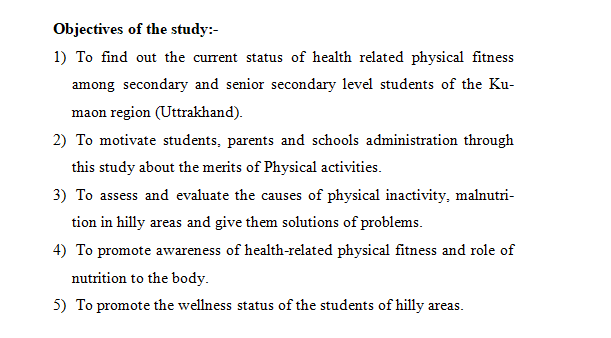TO ASSESS HEALTH-RELATED PHYSICAL FITNESS COMPONENTS AND NUTRITIONAL STATUS AMONG SECONDARY-LEVEL STUDENTS OF DISSIMILAR SCHOOLS OF THE KUMAON REGION
Abstract
Health-related physical fitness refers to a type of physical fitness that consists of cardio-vascular endurance, muscular fitness (strength and endurance), flexibility, and body composition. Fitness is a key indicator of health in school children can predict the health status in the later phases of the student’s life. The present study or investigation will analyze or assess health-related fitness components, nutritional status among secondary and senior secondary-level students between 14 to 18 years age group of dissimilar schools of the Kumaon region (Uttrakhand) through various variables of health-related fitness such as (1)-One mile walk/run test to measure Cardio-respiratory Endurance, (2)-Hand grip strength test to determine muscular Strength (3)- Modified sit-ups test to assess muscular Endurance (4)- Sit and reach test to evaluate flexibility and Body Composition with the help of Body Mass Index test, Nutrition Status can be evaluated with Anthropometric measurements like Age, weight, Height. The study is carried out 900 (nine hundred) boys students of dissimilar schools of the Kumaon region. The present study is based on five category’s schools for instance KVS, JNVs, GICs (Rajkiya Inter College), Government-Aided, and Private unaided schools.
Downloads
References
AAPHERD, Health Related Physical Fitness Test Manual. Association Drive Reston Virginia, 1980, ISBN 0-88314-098-5.
ACSM Fitness Book, Leisure Press Campaign IIIinois, Leisure Press, 1992, 9.
Ahlawat, Ravindra Pal. Health Education and Nutrition. Khel Sahitya Kendra, 2009. ISBN 978-8175245563.
Albon, H. M., Hamlin, M. J., & Ross, J. J. (2010). Secular trends and distribu-tional changes in health and fitness performance variables of 10-14-year-old children in New Zealand between 1991 and 2003. Br J Sports Med, 44(4), 263-269.
American Alliance for Health, Physical Education. Recreation and Dance, Health Related Physical Fitness Test Manual, 1990, Association Drive, Reston, VA 1980, 5.
American College of Sports Medicine. ACSM Fitness Books, Leisure Press Campaign, IIIinois, Leisure Press, 1993, 9.
Anderson, J.K. (1985). Hunting in the Ancient World. Berkeley, CA: University of California Press.
Anspaugh DJ, Hamrick MH, Rosato FD. Wellness: Concepts and applications. McGraw-Hill Higher Education, 2011.
Ashely Cooper, PhD, Lars Bo Andersen, PhD, NielsWedderkopp, MD, Angie S Page, PhD, KarstenFrobery PhD (2005): Physical activity levels of children who walk, cycle, or are driven to school.
Baranowski, T., Bouchard, C., Bar-Or, O., Bricker, T., Heath, G., Kimm, S.Y.S., Malina, R., Obarzanek, E., Pate, R., Strong, W.B., Truman, B. and Washington, R. (1992). Assessment, prevalence, and cardiovascular benefits of physical activity and fitness in youth. Medicine and Science in Sports and Exercise, vol.24, pp 237-247.
Barrow, H.M. and Brown, J.P. (1988). Man and Movement: Principles of Physi-cal Education. 4th Ed. Philadelphia Lea &Febiger.
Berryman, J.W. (1995) Out of Many, ONE: A History of the American College of Sports Medicine. Champaign, IL: Human Kinetics.
Bogert, L. Jean, George M. Briggs, and Doris Howes Calloway. 1973. Nutrition and Physical Fitness. Philadelphia: Saunders. ISBN 0721618170.
Kuppuswamy B. Manual of Socioeconomic Status (Urban). Del-hi:Manasayan;1981.
National Institute of Open Schooling), January (2019). (An autonomous organi-sation under MHRD, Govt. of India.
Singh, M., Kadhim, M.M., Turki Jalil, A. et al. A syste-matic review of the protective effects of silyma-rin/silibinin against doxorubicin-induced cardiotoxici-ty. Cancer Cell Int 23, 88 (2023). https://doi.org/10.1186/s12935-023-02936-4 https://cancerci.biomedcentral.com/articles/10.1186/s12935-023-02936-4
Mandeep Singh Nathial, A Study of Adjustment and Emotional In-telligence of University Coaches in India, American Journal of Ap-plied Psychology. Volume 3, Issue 6, November 2014 , pp. 122-126. doi: 10.11648/j.ajap.20140306.11
Nathial, Mandeep Singh. A COMPARATIVE AND ANALYTICAL STUDY OF SELF-ESTEEM AND JOB SATISFACTION IN ATHLETES AND NON ATHLETES. Journal of Advances in Social Science and Humani-ties, 2(10).https://doi.org/10.15520/jassh210123
Singh, M., Kour, R., &Kour, A.,. A collaborative diversified inves-tigation of respective responses of sports person coaches and organ-izations on criminalization of doping.International Journal of Health Sciences,6(S3), 11295–11310. https://doi.org/10.53730/ijhs.v6nS3.8641
Mandeep Singh., Assessment of Vocational Interests of Paha-di&Bakarwal School Students In Relation To Their Gender. Int J Recent Sci Res. 9(3), pp. 24817-24819. DOI: http://dx.doi.org/10.24327/ijrsr.2018.0903.1731
Dr. Mandeep Singh, 2017. “A study of awareness of inhouse dop-ing errors among national level players and sports administrators in J&K state of India”, International Journal of Current Research, 9, (01), 45226-45227. http://www.journalcra.com/sites/default/files/issue-pdf/20036.pdf
Mandeep Singh, 2019; “Effect of Mobile Screen Psychomotor Digital Image Motivators in Person Technique in Reducing An-xiety Level of Intervarsity Players of Cluster University Jammu, Blue Eyes Intelligence Engineering and Sciences Publication (BEIESP). Volume-9 Issue-1, October 2019, PP: 3750-3752, DOI: 10.35940/ijeat.A9811.109119. https://www.ijeat.org/portfolio-item/A9811109119/
Mandeep Singh. (2018). THE AWARENESS OF MOVEMENT AND FITNESS SCIENCES AMONG SCHOOL, UNDER GRADUATE AND POST GRADUATE LEVEL STUDENTS: EMPOWERING EDUCATION THROUGH PHYSICAL EDUCATION. European Journal of Physical Education and Sport Science, 4(3).https://doi.org/10.5281/zenodo.1218149
Khelo India, (2018) https://schoolfitness.kheloindia.gov.in
Government of India. (1950,). Constitution of India. New Delhi: Ministry of Law and Justice. Retrieved 01 05, 2016, from http://lawmin.nic.in/olwing/coi/coi-english/coi-4March2016.pdf
Haywood, K. M., & Getchell, N. (2009). Life span motor development. Cham-paign: Human Kinetics.

Copyright (c) 2023 MR. GANGA DHAR VERMA, DR. NEERU MALIK

This work is licensed under a Creative Commons Attribution 4.0 International License.














